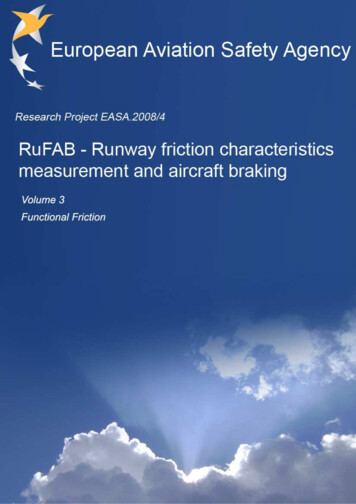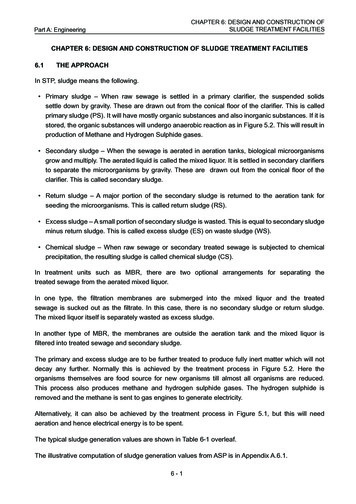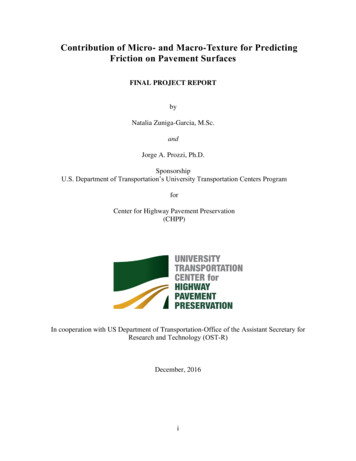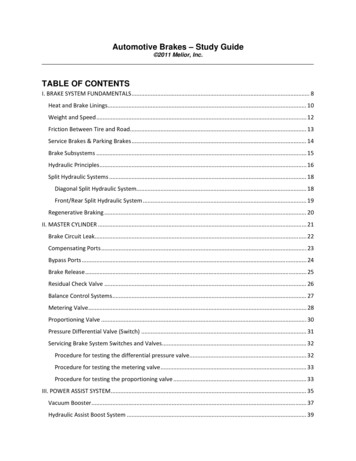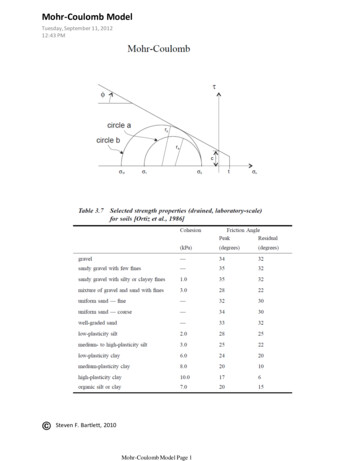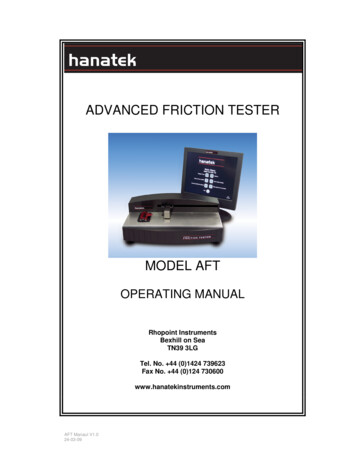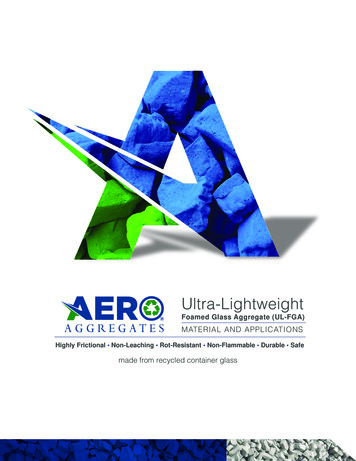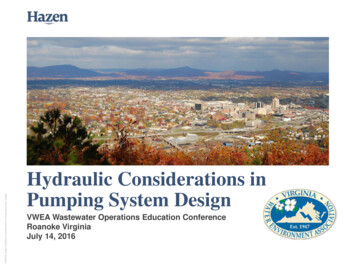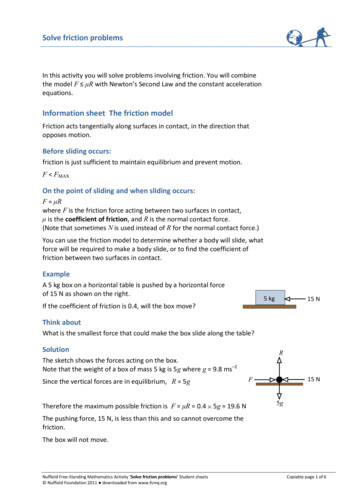
Transcription
Solve friction problemsIn this activity you will solve problems involving friction. You will combinethe model F μR with Newton’s Second Law and the constant accelerationequations.Information sheet The friction modelFriction acts tangentially along surfaces in contact, in the direction thatopposes motion.Before sliding occurs:friction is just sufficient to maintain equilibrium and prevent motion.F FMAXOn the point of sliding and when sliding occurs:F μRwhere F is the friction force acting between two surfaces in contact,μ is the coefficient of friction, and R is the normal contact force.(Note that sometimes N is used instead of R for the normal contact force.)You can use the friction model to determine whether a body will slide, whatforce will be required to make a body slide, or to find the coefficient offriction between two surfaces in contact.ExampleA 5 kg box on a horizontal table is pushed by a horizontal forceof 15 N as shown on the right.5 kg15 NIf the coefficient of friction is 0.4, will the box move?Think aboutWhat is the smallest force that could make the box slide along the table?SolutionRThe sketch shows the forces acting on the box.Note that the weight of a box of mass 5 kg is 5g where g 9.8 ms–2Since the vertical forces are in equilibrium, R 5gTherefore the maximum possible friction is F μR 0.4 5g 19.6 NF15 N5gInformation SheetThe pushing force, 15 N, is less than this and so cannot overcome thefriction.The box will not move.Nuffield Free-Standing Mathematics Activity ‘Solve friction problems’ Student sheets Nuffield Foundation 2011 downloaded from www.fsmq.orgCopiable page 1 of 6
ExampleA 400-gram package lying on a horizontal surface is attached to a horizontalstring which passes over a smooth pulley.400 gWhen a mass of 200 grams is attached to the other end of the string,the package is on the point of moving.200 gFind , the coefficient of friction.Think aboutWhat forces are acting on the package?SolutionRThe forces acting on the package are as shown.Since the vertical forces are in equilibrium, R 0.4gOn the point of moving, F μR μ 0.4g and F TAs the pulley is smooth, the tension in the string, T 0.2gThis gives μ 0.4g 0.2g and so μ 0. 2 g 0. 4 gTF0.4g12Information SheetApplying this techniqueYou should now be able to answer Questions 1–5 on page 4.More complex problems can be solved using the model F μR(when an object is on the point of sliding or when sliding is occurring)together with other equations.In particular, the following may be useful.Newton's Second LawResultant force mass accelerationwhere the resultant force is in newtons, N; the mass is in kg; and theacceleration is in m s–2.Equations for motion in a straight line with constant accelerationv u ats u v t2s ut 12 at2andv 2 u 2 2aswhere u is the initial velocity, v is the final velocity, a is the acceleration, t isthe time taken and s is the displacement.Nuffield Free-Standing Mathematics Activity ‘Solve friction problems’ Student sheets Nuffield Foundation 2011 downloaded from www.fsmq.orgCopiable page 2 of 6
Think aboutWhy does the friction model allow us to use these equations?ExampleA car of mass 1.2 tonnes is travelling along a straight horizontal road at aspeed of 20 ms–1 when it brakes sharply then skids.Friction brings the car to rest.If the coefficient of friction between the tyres and road is 0.8, calculatea the decelerationb the distance travelled by the car before it comes to rest.Think aboutRWhat is the value of the friction while the car is skidding?Solutiona The sketch shows the forces acting on the car when it is skidding.Since the vertical forces are in equilibrium RF μRSince the car is skiddingF 1200g1200g 0.8 1200g 9408 NThe friction F causes deceleration a which is given by Newton's Second Law, F ma9408a –– 9408 1200aso – 7.841200The deceleration is 7.84 ms–2Think aboutNow that the deceleration is known, which of the equations of motion canbe used to find the distance travelled?b Using v 2 u 2 2as with initial speed u 20 ms–1, final speed v 0 ms–1and acceleration a – 7.84 ms–202 202 – 2 7.84 s 15.68 s 400 s The car travels 25.5 m (to 3 sf) before coming to rest.400 25.515.68You should now be able to answer questions 6 to 11 on page 6.Nuffield Free-Standing Mathematics Activity ‘Solve friction problems’ Student sheets Nuffield Foundation 2011 downloaded from www.fsmq.orgCopiable page 3 of 6
Try theseTake g 9.8 ms–22 kg1a A parcel of mass 2 kg lies at rest on a rough horizontal surface, as shown.i Draw a force diagram showing the forces acting on the parcel.ii Calculate the normal contact force, R.b The parcel is now pushed with a horizontal force P, as shown, so that it isjust on the point of sliding.i Draw a force diagram showing the forces now acting on the parcel.ii If the coefficient of friction is 0.5, find the value of P when the parcel is onthe point of sliding.2 kgP40 N2 A dustbin of mass 12 kg standing on horizontal ground is pushed by ahorizontal force of 40 N.12 kgIf the coefficient of friction is 0.4, will the dustbin move?3 A conveyor belt is used to carry cans from one part of a factory toanother. Each can has mass 350 grams.If μ 34and each can is just on the point of sliding,find the frictional force acting on each can.4 A sledge has mass 15 kg. A horizontal pull of 25 N will just move thesledge when it is on a horizontal surface of compacted snow.a Draw a diagram showing the forces acting on the sledge, modelled as aparticle, when it is just on the point of sliding on this horizontal surface.b Find a value for , the coefficient of friction between the surfaces.5 One end of a light inextensible string is attached to a tool boxof mass 2.5 kg which is lying on a horizontal table.The string passes over a smooth pulley and is tied at the otherend to a bag of mass 1.4 kg.a Draw a diagram showing the forces acting on the tool box.b If the tool box is just on the point of sliding, find a value for μ,the coefficient of friction.Nuffield Free-Standing Mathematics Activity ‘Solve friction problems’ Student sheets Nuffield Foundation 2011 downloaded from www.fsmq.orgCopiable page 4 of 6
Combining the friction model with Newton’s Second Law and theconstant acceleration equationsIn the following problems you will need to combine the friction model withNewton’s Second Law and the constant acceleration equations.6 A car of mass 1 tonne is travelling along a straight horizontal road at15 ms–1 when it brakes sharply then skids. Friction brings the car to rest.If the coefficient of friction between the tyres and road is 0.75, calculate:a the decelerationb the time taken for the car to come to rest.7 A cup of coffee of mass 250 grams sits on a table in a train carriage. Thetrain accelerates at 1.2 ms–2 out of a station.a Draw the forces acting on the cup of coffee.b If the cup does not slip, find the value of the friction force acting on thecup of coffee.c If the cup is just about to slip, find the coefficient of friction between thecup and the surface of the table.8 A woman is trying to push a load of mass 50 kg across a floor. The womanexerts a force of 70 N.a Modelling the floor as smooth and the load as a particle, calculate theacceleration of the load.b Assuming that a constant resistive force of 56 N is acting, calculate:i the acceleration of the loadii the coefficient of friction, , between the load and the ground, assumingthe resistive force is due only to friction.9 A trunk of mass 30 kg is standing on a horizontal floor.The coefficient of friction, μ, between the trunk and floor is 0.3.a Find the maximum value the friction can attain.b Find the force that is necessary:i to keep the trunk sliding over the floor with constant speedii to cause the trunk to slide over the floor with acceleration 0.2 ms–2.Nuffield Free-Standing Mathematics Activity ‘Solve friction problems’ Student sheets Nuffield Foundation 2011 downloaded from www.fsmq.orgCopiable page 5 of 6
10 A pick-up truck carrying a load of mass 150 kg accelerates from sometraffic lights at 1.4 ms – 2.150 kgFind the smallest possible value of the coefficient of friction if the loaddoes not slip.11 A boy slides a flat stone across a frozen pond. The stone has a mass of100 grams, and the coefficient of friction, μ, between the stone and the ice is0.1. The stone has an initial speed of 8 ms–1.Find how far the stone will travel before it comes to rest.ExtensionA typical value for the coefficient of friction between rubber and concrete is1.0. If you used this value for μ in Question 6 rather than 0.75, how would itaffect your answers?In some of the questions you have just attempted, you were given the valueof the coefficient of friction between the two surfaces in contact. Howwould your answers be affected if the coefficient of friction were different?What if were halved or doubled?Think aboutCould you use your previous working to estimate new answers for differentvalues of μ?Could you work algebraically to obtain answers in terms of μ?Could you use a spreadsheet to show how changing μ affects the answers tothe questions?Reflect on your workYou have used the model F μR to solve a range of problems involvingfriction. What factors determine whether you can use F μR?You have seen that friction can be the force causing a body to move, or itcan be opposing motion. Can you think of any other situations in whichfriction is either causing a body to accelerate or is trying to prevent motion?Could you use the mathematics you have used in this activity to model thesesituations?Nuffield Free-Standing Mathematics Activity ‘Solve friction problems’ Student sheets Nuffield Foundation 2011 downloaded from www.fsmq.orgCopiable page 6 of 6
Think about . Why does the friction model allow us to use these equations? Example . A car of mass 1.2 tonnes is travelling along a straight horizontal road at a speed of 20 ms -1. when it brakes sharply then skids. Friction brings the car to rest. If the coefficient of friction between the tyres and road is 0.8, calculate . a. the .


